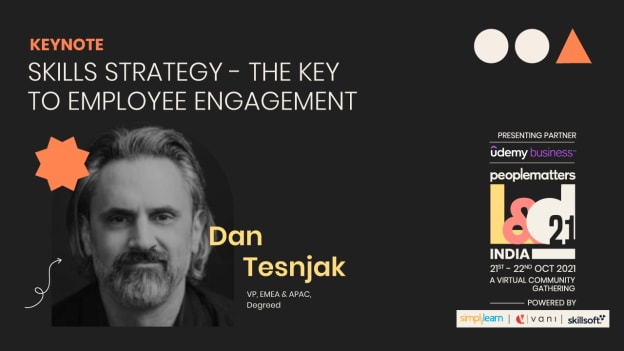Skills Strategy: The key to employee engagement

The evolving world is embracing career mobility, learning and development investments, talent growth and aiding employees to manage their careers inside the organisation. The idea is to not just ensure career mobility but an engaged workforce. So how do we manage skill and how should employers and organization's strategic learning and skill enhancement to achieve optimal employee engagement?
In an exclusive webcast at People Matters L&D Conference 2021, Anushree Tiwari, Strategic Account Director at Degreed, shared her insights on how to build an engaging and effective skills strategy.
Not having the right skills at the right time for the right cause may lead organisations to fail in the longer term. McKinsey and Co summarised that organisations that expect to benefit from a digital transformation strategy or a promising new strategy, might fail if they do not have the right talent to execute the plan efficiently. The prevailing talent gap could eventually be fatal and hamper competitive liability in the forthcoming years. A diverse and extensive skills data of the organisation is very crucial. It is necessary to formulate organisational level, functional or team level strategies as well as scaling initiatives. A purely top down skill strategy is quite slow and too cumbersome due to the changing times. organisations prefer to have a design in which the skills strategy is formulated and driven at an odd level with the course of time. L&D and talent teams must create an environment where individual learners and stakeholders can play their roles dynamically throughout the process. Creating a skill strategy for skill-building and organisational effectiveness is a time taking process. It involves strategic decision points and initiatives.
Companies are focusing more on role-based learning journeys to ensure an enhanced learning experience which will help them upskill in the most seamless way. It further ensures amplified employee engagement, right. At the same time, organisations need to be careful about collection of learning and skills data. Deep analysis over skill portions and data insights as to what are the missing pieces is of utmost importance.
How to utilise data to increase employee engagement
Data mine and supply of critical skills is what an organisation needs within its talent pool. Activation of skill-sets, infusion of skill data, maintaining a skills glossary and utilising the same on the company's design and strategy. Skills being the central currency become transactional for employees. They can use the skills portfolio for newer job roles, for career elasticity. It can enable employees the need for additional skill-sets for larger roles. The connection between the learning and talent teams is also something that is very critical.
If skills is that central fabric on which the entire ecosystem runs, just one team such as the L&D team, or just one single thing that works under HR or business strategies, etc will not work. It is a very comprehensive and complex process that requires participation and effort from a range of other teams as well, and is a very close knit relation between the learning, talent, talent planning and workforce mobilisation teams.
Skill strategy
An organization when successfully puts the skills data to use, it is crucial for them to maintain mobility across segments within the company. At this point employees will be able to democratize high potential identification. People will themselves be able to see what are the options available for them. An organization will be able to amplify succession. If a company is able to pull off this journey, this entire career experience for individual employees and the ecosystem design, this is when one calls it the right skill strategy for a company.
Hence, it is vital to address these questions:
- What are those top two business problems that your organization is adapting gradually?
- Why is digital transformation required? Is that impacting business influx and what are the competitive advantages?
- How do you help your employees build career elasticity, are you giving them enough enablement to identify those career options for themselves?
- Are you allowing enough skilling abilities, which if they take up can actually result in elasticity for themselves as well?
- What are the business outcomes and what your learning or skill strategy is going to deliver on?
Best practices on how the skills can be owned and nurtured by all
Skills must be democratised. It is not one single business unit or an individual entity's responsibility. Ideally, a skill strategy is set by the leaders, which is further communicated by the HR teams aiding implementation of strategic business initiatives. While, managers provide the environment where team members perform up to their potential along with the bandwidth to develop themselves individually alongside these scaling initiatives.
When an organisation has established the skill base system in place, with all the strategy, skills, data analytics, etc, the accountability of building skills resides with the employees. An employee's skill profile testifies their actual potential and highlights the skimming areas. It is pertinent for an organisation to identify the skills required to move forward in execution of strategies. Further, focusing on skilling efforts, learning experiences and mobility actions is evidently critical.












